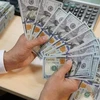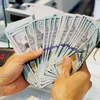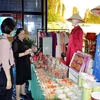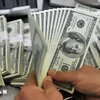Total retail sales of commodities and services surged by 24.5 percent year on year to 1,561 trillion VND (roughly 78 billion USD) in 2010, or 1,100 trillion VND higher than the set target.
The tourism and trade sectors recorded the highest annual growth rates, at 28 percent and 25 percent, respectively.
The retail industry has annually contributed over 15 percent to the country’s gross domestic product (GDP) and created stable jobs for more than 5.4 million workers, representing over 10 percent of the total workforce.
The Ministry of Industry and Trade (MoIT) attributed these positive results to the government’s demand stimulus policy as well as businesses’ success in taking full advantage of prices.
This move has been manifested by consecutive large promotions offered by both producers and distributors. During the year-end and Noel promotional campaigns alone, the purchasing power at a number of supermarkets in the two biggest cities of Hanoi and Ho Chi Minh City soared by approximately 30 percent compared with the same period of 2009.
MoIT said the domestic market is becoming a “fulcrum” to foster business and production, and recover growth, thus contributing greatly to the national economy’s sustainable development economy. Despite its small scale, Vietnam ’s retail market remained very attractive to investors, especially those from outside.
A survey conducted in the fourth quarter of 2010 by the audit firm Grant Thornton Vietnam shows that the Vietnamese retail market has lured more foreign investors, as 70 percent of correspondents considered retail as a more fascinating and promising investment field than others such as education, real estate and healthcare.
Another survey recently released by the market research company Nielsen indicates more than 80 percent of producers are optimistic that their business would post two-digit growth rates within the next 6-12 months. In particular, up to 80 percent of them are planning to expand outlets to rural areas.
With these positive signals, Vietnam ’s retail market is likely to retain an average annual growth rate of between 20-25 percent in the years to come. The country’s retail sales are forecast to reach 85 billion USD by 2012./.
The tourism and trade sectors recorded the highest annual growth rates, at 28 percent and 25 percent, respectively.
The retail industry has annually contributed over 15 percent to the country’s gross domestic product (GDP) and created stable jobs for more than 5.4 million workers, representing over 10 percent of the total workforce.
The Ministry of Industry and Trade (MoIT) attributed these positive results to the government’s demand stimulus policy as well as businesses’ success in taking full advantage of prices.
This move has been manifested by consecutive large promotions offered by both producers and distributors. During the year-end and Noel promotional campaigns alone, the purchasing power at a number of supermarkets in the two biggest cities of Hanoi and Ho Chi Minh City soared by approximately 30 percent compared with the same period of 2009.
MoIT said the domestic market is becoming a “fulcrum” to foster business and production, and recover growth, thus contributing greatly to the national economy’s sustainable development economy. Despite its small scale, Vietnam ’s retail market remained very attractive to investors, especially those from outside.
A survey conducted in the fourth quarter of 2010 by the audit firm Grant Thornton Vietnam shows that the Vietnamese retail market has lured more foreign investors, as 70 percent of correspondents considered retail as a more fascinating and promising investment field than others such as education, real estate and healthcare.
Another survey recently released by the market research company Nielsen indicates more than 80 percent of producers are optimistic that their business would post two-digit growth rates within the next 6-12 months. In particular, up to 80 percent of them are planning to expand outlets to rural areas.
With these positive signals, Vietnam ’s retail market is likely to retain an average annual growth rate of between 20-25 percent in the years to come. The country’s retail sales are forecast to reach 85 billion USD by 2012./.



















